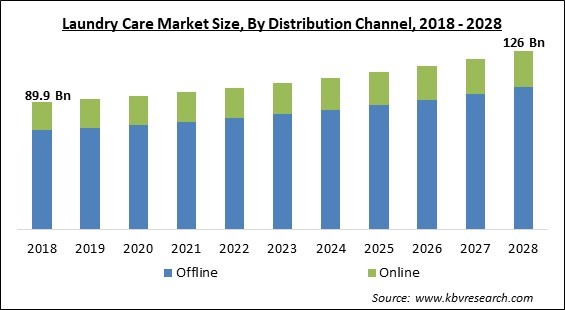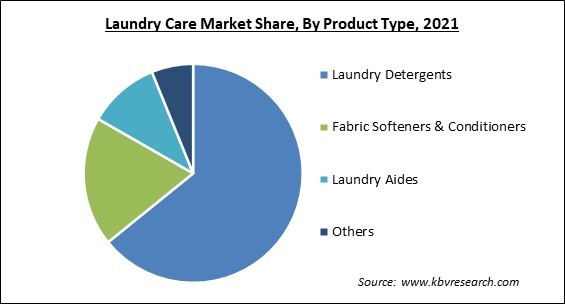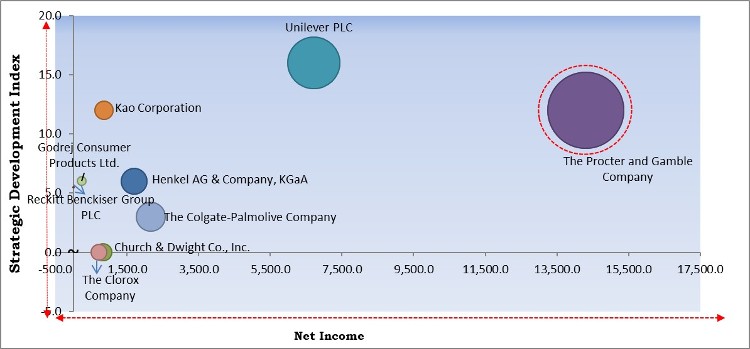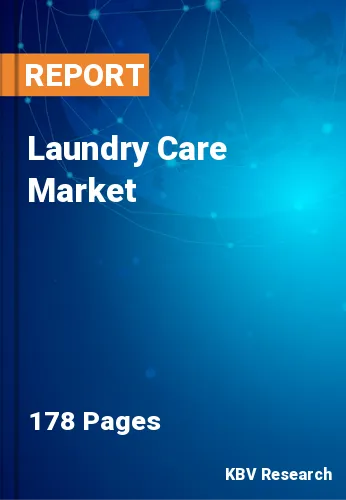The Global Laundry Care Market size is expected to reach $126 billion by 2028, rising at a market growth of 3.9% CAGR during the forecast period.
Fabric wash and care products are used to keep garments from deteriorating due to normal washing and use. These things are also utilized for cleaning in a variety of industries, including automotive and aviation. The fabric wash and care business is being pushed by population growth and disposable income among middle-class customers in emerging countries.
Laundry care products, also known as, washing and fabric care products are utilized to clean furniture and clothing. Cleaning chemicals are necessary to maintain the cloth supple and clean. Detergent, soaps, fabric softeners, bleach, and other fabric wash products are available on the market. Different styles of clothing require different sorts of maintenance, such as dry cleaning or hand washing, to keep them looking their best. Fabric goods can be utilized on a variety of clothes for different seasons. Acrylic, denim, cotton, linen, microfiber, polyester, nylon, rayon, velvet, silk, lycra, and wool are among the materials suited for fabric cleaning. As the population rises and middle-class clients' income levels rise, the market demand for fabric care and washing has increased. Customers are willing to spend a larger portion of their disposable cash to keep their clothes clean. As a result, they invest more in the highest-quality fabric care and cleaning supplies. Another factor driving the need for fabric wash and care is the increased production of equivalent items in China and other Asian countries.
One has to wash their clothing every day and it is an essential part of daily routine. A decent detergent is essential for optimum health. Germs and other dangerous elements come into contact with the clothes when people touch various surfaces. Those contaminants are washed away with detergent. Some detergents give the clothes a pleasant scent. Customers can easily choose the right detergent for their needs from the many varieties available on the market. Different kinds of detergents are available

The COVID-19 pandemic caused disarray in the world. The spread of the virus prompted governments to implement lockdowns and restrictions on movement for people all throughout the world. The virus also resulted in millions of deaths. However, despite supply chain bottlenecks, many industry participants recorded higher sales during the pandemic as a result of increased demand for cleaning supplies. People have been highly concerned about their cleanliness since the outbreak of COVID-19. Sales of sanitizers, disinfectants, and laundry detergent increased during the mass hysteria induced by the outbreak of this pandemic. People also entered into a scarcity mentality due to the lockdowns and started buying laundry products in bulk for hoarding.
A growing concern among individuals about health and sanitary living, free of germs, bacteria, dust, and filth, has resulted in an increase in per capita spending on household cleaning goods, particularly laundry detergents. In recent years, scent has become increasingly important in household cleaning goods as consumers want products with a strong pleasant odor, forcing vendors to differentiate their products. Furthermore, factors such as an increase in household expenditure and growth in the real estate industry due to an increase in residential units have raised the demand for laundry detergent products.
Organic detergents and cleansers have regularly outperformed chemical detergents and cleaners. They are preferred over chemical-based substances because they contain ingredients derived from plants. Even freshly washed clothes may feel sticky if the detergent is chemical-based. When natural detergents are used to wash garments, this is not the case. Another advantage of using organic detergents is that they consume fewer products. Clothes are in constant contact with the skin throughout the day. If harsh or chemical-based cleaning agents are used, there is a potential that some residue will remain in the clothes and come into contact with the skin.
Surfactants in synthetic detergents eventually biodegrade to low toxicity levels, but the process is gradual and hence causes environmental issues. Synthetic detergents contain a variety of surfactants, but Alkylphenol ethoxylates are a major problem for fish and other aquatic life, according to the Environmental Protection Agency. This surfactant accumulates in rivers and streams, poisoning fish by affecting the endocrine system, which controls growth, reproduction, and metabolism. As people are getting more environmentally conscious, these factors are likely to impede the growth of the laundry care market in the upcoming years.

Based on Product Type, the market is segmented into Laundry Detergents, Fabric Softeners & Conditioners, Laundry Aides, and Others. Fabric conditioners and softeners, which help keep textiles soft, are anticipated to see greater demand as the demand for high-end clothes rises. Concerns over the use of chemicals like quaternary ammonium compounds, which can cause skin problems, are driving the need for biodegradable items. Manufacturers are likely to spend more on R&D and the launch of innovative products as a result of this aspect. The segment expanded due to the rising demand for quality clothing that is clean. Fabric softeners and conditioners are expected to rise in popularity in the coming years as the young population's preference for high-end products grows.
Based on Distribution Channel, the market is segmented into Offline and Online. The offline segment acquired the highest revenue share in the laundry care market in 2021. Specialty stores, hypermarkets, supermarkets, and independent retail stores all fall within the offline category. In the coming years, the expansion of the organized retail sector in developing economies such as India, Malaysia, and China is predicted to boost demand for laundry care products. In the coming years, the increased availability of product kinds in supermarkets and other offline distribution channels is predicted to support the offline distribution channel's growth. As a result, all of these factors are likely to increase this segment's growth throughout the forecast period.
| Report Attribute | Details |
|---|---|
| Market size value in 2021 | USD 96.8 Billion |
| Market size forecast in 2028 | USD 126 Billion |
| Base Year | 2021 |
| Historical Period | 2018 to 2020 |
| Forecast Period | 2022 to 2028 |
| Revenue Growth Rate | CAGR of 3.9% from 2022 to 2028 |
| Number of Pages | 178 |
| Number of Tables | 264 |
| Report coverage | Market Trends, Revenue Estimation and Forecast, Segmentation Analysis, Regional and Country Breakdown, Competitive Landscape, Companies Strategic Developments, Company Profiling |
| Segments covered | Product Type, Distribution Channel, Region |
| Country scope | US, Canada, Mexico, Germany, UK, France, Russia, Spain, Italy, China, Japan, India, South Korea, Singapore, Malaysia, Brazil, Argentina, UAE, Saudi Arabia, South Africa, Nigeria |
| Growth Drivers |
|
| Restraints |
|
Based on Regions, the market is segmented into North America, Europe, Asia Pacific, and Latin America, Middle East & Africa. The Asia Pacific acquired the highest revenue share in the laundry care market in 2021. Since the bulk of laundry care products is used in this region, Asia Pacific has such a high revenue share. Furthermore, rising disposable income and an expanding population are propelling this sector forward. Expanding economies such as India and China, a growing working population, and higher spending on cleaning and laundry goods are expected to drive the market throughout the projection period. China is a significant shareholder in the Asia Pacific due to the presence of a big population seeking quick dry-cleaning and laundry care goods to preserve personal hygiene.
Free Valuable Insights: Global Laundry Care Market size to reach USD 126 Billion by 2028

The major strategies followed by the market participants are Product Launches. Based on the Analysis presented in the Cardinal matrix; The Procter and Gamble Company is the major forerunner in the Laundry Care Market.
The market research report covers the analysis of key stake holders of the market. Key companies profiled in the report include The Procter and Gamble Company, Unilever PLC, Kao Corporation, Henkel AG & Company, KGaA, The Clorox Company, Reckitt Benckiser Group PLC, The Colgate-Palmolive Company, Church & Dwight Co., Inc., Godrej Consumer Products Ltd., and S. C. Johnson & Son, Inc.
By Product Type
By Distribution Channel
By Geography
The laundry care market size is projected to reach USD 126 billion by 2028.
Increasing demand due to rising disposable income are increasing are driving the market in coming years, however, surfactants and artificial colorants growth of the market.
The Procter and Gamble Company, Unilever PLC, Kao Corporation, Henkel AG & Company, KGaA, The Clorox Company, Reckitt Benckiser Group PLC, The Colgate-Palmolive Company, Church & Dwight Co., Inc., Godrej Consumer Products Ltd., and S. C. Johnson & Son, Inc.
The expected CAGR of the laundry care market is 3.9% from 2022 to 2028.
The Laundry Detergents segment acquired maximum revenue share in the Global Laundry Care Market by Product Type in 2021, thereby, achieving a market value of $77,171 Million by 2028.
The Asia Pacific is the fastest growing region in the Global Laundry Care Market by Region in 2021, and would continue to be a dominant market till 2028.
Our team of dedicated experts can provide you with attractive expansion opportunities for your business.

